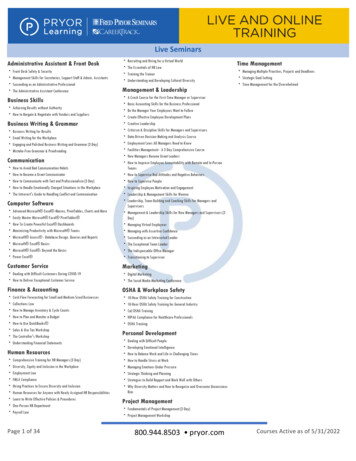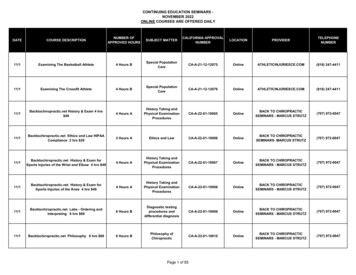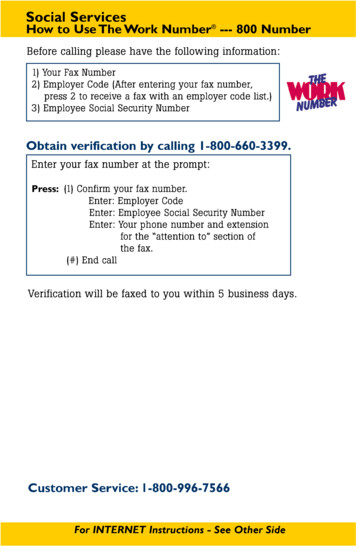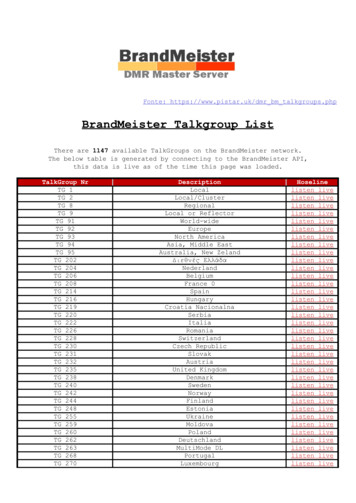
Transcription
Live SeminarsAdministrative Assistant & Front Desk Front Desk Safety & SecurityManagement Skills for Secretaries, Support Staff & Admin. AssistantsSucceeding as an Administrative ProfessionalThe Administrative Assistant ConferenceBusiness Skills Achieving Results without AuthorityHow to Bargain & Negotiate with Vendors and SuppliersBusiness Writing & Grammar Business Writing for ResultsEmail Writing for the WorkplaceEngaging and Polished Business Writing and Grammar (2-Day)Mistake-Free Grammar & ProofreadingCommunication How to Avoid Bad Communication HabitsHow to Become a Great CommunicatorHow to Communicate with Tact and Professionalism (2-Day)How to Handle Emotionally Charged Situations in the WorkplaceThe Introvert's Guide to Handling Conflict and CommunicationComputer Software Advanced Microsoft Excel -Macros, PivotTables, Charts and MoreEasily Master Microsoft Excel PivotTables How To Create Powerful Excel DashboardsMaximizing Productivity with Microsoft TeamsMicrosoft Access - Database Design, Queries and ReportsMicrosoft Excel BasicsMicrosoft Excel : Beyond the BasicsPower Excel Customer Service Dealing with Difficult Customers During COVID-19How to Deliver Exceptional Customer ServiceFinance & Accounting Cash Flow Forecasting for Small and Medium-Sized BusinessesCollections LawHow to Manage Inventory & Cycle CountsHow to Plan and Monitor a BudgetHow to Use QuickBooks Sales & Use Tax WorkshopThe Controller's WorkshopUnderstanding Financial StatementsHuman Resources Comprehensive Training for HR Managers (2-Day)Diversity, Equity and Inclusion in the WorkplaceEmployment LawFMLA ComplianceHiring Practices to Ensure Diversity and InclusionHuman Resources for Anyone with Newly Assigned HR ResponsibilitiesLearn to Write Effective Policies & ProceduresOne-Person HR DepartmentPayroll LawPage 1 of 34 Recruiting and Hiring for a Virtual WorldThe Essentials of HR LawTraining the TrainerUnderstanding and Developing Cultural DiversityManagement & Leadership Time Management Managing Multiple Priorities, Projects and DeadlinesStrategic Goal-SettingTime Management for the OverwhelmedA Crash Course for the First-Time Manager or SupervisorBasic Accounting Skills for the Business ProfessionalBe the Manager Your Employees Want to FollowCreate Effective Employee Development PlansCreative LeadershipCriticism & Discipline Skills for Managers and SupervisorsData-Driven Decision Making and Analysis CourseEmployment Laws All Managers Need to KnowFacilities Management - A 2-Day Comprehensive CourseHow Managers Become Great LeadersHow to Improve Employee Accountability with Remote and In-PersonTeamsHow to Supervise Bad Attitudes and Negative BehaviorsHow to Supervise PeopleInspiring Employee Motivation and EngagementLeadership & Management Skills for WomenLeadership, Team-Building and Coaching Skills for Managers andSupervisorsManagement & Leadership Skills for New Managers and Supervisors (2Day)Managing Virtual EmployeesManaging with Assertive ConfidenceSucceeding as an Introverted LeaderThe Exceptional Team LeaderThe Indispensable Office ManagerTransitioning to SupervisorMarketing Digital MarketingThe Social Media Marketing ConferenceOSHA & Workplace Safety 10-Hour OSHA Safety Training for Construction10-Hour OSHA Safety Training for General IndustryCal/OSHA TrainingHIPAA Compliance for Healthcare ProfessionalsOSHA TrainingPersonal Development Dealing with Difficult PeopleDeveloping Emotional IntelligenceHow to Balance Work and Life in Challenging TimesHow to Handle Stress at WorkManaging Emotions Under PressureStrategic Thinking and PlanningStrategies to Build Rapport and Work Well with OthersWhy Diversity Matters and How to Recognize and Overcome UnconsciousBiasProject Management Fundamentals of Project Management (2-Day)Project Management Workshop800.944.8503 pryor.comCourses Active as of 5/31/2022
OnDemand CoursesAdministrative Assistant & Front Desk 50 Training Activities for Administrative, Secretarial, and Support StaffActing as GatekeeperAnticipating NeedsAssertiveness Skills for the ReceptionistBe the Point PersonDetail-Oriented Skill DevelopmentEffective Telephone Communication Skills for ReceptionistsMaking Travel ArrangementsManaging the Front DeskOrganization: CalendarsOrganization: EmailsOrganization: Filing SystemsOrganization: Taking InventoryOrganization: VoicemailsPlanning and Coordinating EventsPreparing a Room for a MeetingPrioritization TechniquesProfessional Telephone SkillsRouting a ProblemSafety and Security Begins at the Front DeskTelephone Techniques: GreetingTelephone Techniques: Handling Angry CallersTelephone Techniques: Hold PleaseTelephone Techniques: Phone EtiquetteTelephone Techniques: Taking CallsTelephone Techniques: Taking MessagesBusiness Skills A Guide to WhistleblowingA Unified Communications Strategy for ContentApplying Design ThinkingBe a Math RockstarBe a Math Rockstar Part 2!Becoming an Asset: Understanding Your CompanyBecoming an Asset: Understanding Your IndustryBuilding a Framework for ExecutionBusiness AnalysisBusiness Attire Basics for Men: Black Tie AttireBusiness Attire Basics for Men: Black Tie Optional AttireBusiness Attire Basics for Men: Business Casual AttireBusiness Attire Basics for Men: Business Formal AttireBusiness Attire Basics for Men: Casual AttireBusiness Attire Basics for Men: Semi-Formal/Cocktail AttireBusiness Attire Basics for Women: Black Tie AttireBusiness Attire Basics for Women: Black Tie Optional AttireBusiness Attire Basics for Women: Business Casual AttireBusiness Attire Basics for Women: Business Formal AttireBusiness Attire Basics for Women: Casual AttireBusiness Attire Basics for Women: Semi-Formal/Cocktail AttireBusiness Meals: Attending a Business MealBusiness Meals: Hosting a Business MealBusiness Planning for BeginnersBusiness Process Reengineering (BPR) (Part 1 of 6): IntroductionBusiness Process Reengineering (BPR) (Part 2 of 6): The 3 C'sPage 2 of 34 Business Process Reengineering (BPR) (Part 3 of 6): CharacteristicsBusiness Process Reengineering (BPR) (Part 4 of 6): RequirementsBusiness Process Reengineering (BPR) (Part 5 of 6): Key StepsBusiness Process Reengineering (BPR) (Part 6 of 6): PitfallsBusiness Travel: Before LeavingBusiness Travel: Business TravelBusiness Travel: Hotel, Motel, Holiday InnBusiness Travel: International Business TravelBusiness Travel: I've Got a Plane to CatchBusiness Travel: My Bags Are PackedBusiness Travel: Safe TravelsBusiness Travel: Staying HealthyBusiness Travel: Technology SecurityBusiness Travel: There's an App for ThatCharacter Matters! Character and CourageCharacter Matters! Connecting Character in the WorkplaceCharacter Matters! Standing on PrincipleCognitive Flexibility (Part 1 of 4): Flexible Thinking at WorkCognitive Flexibility (Part 2 of 4): Benefits of Cognitive FlexibilityCognitive Flexibility (Part 3 of 4): Increase Your Cognitive FlexibilityCognitive Flexibility (Part 4 of 4): Physical Influence on CognitiveFlexibilityCommunicating Your Ethics to Your Customers (Part 10 of 13)Communicating Your Ethics To Your Team (Part 09 of 13)Concept Evaluation: Finding SupportConcept Evaluation: Making DecisionsConfidentiality and Intellectual Property Tips and Actions for Success (Part3)Coordinating With Others (Part 1 of 4): Coordinating Gone Wrong!Coordinating With Others (Part 2 of 4): Traits of an Effective CoordinatorCoordinating With Others (Part 3 of 4): Preparing to Coordinate a ProjectCoordinating With Others (Part 4 of 4): How Coordinators Exert ControlCoping with Change: Change BehaviorsCoping with Change: Change ModelCoping with Change: Change PhasesCreating a Statement of Values (Part 11 of 13)Creativity: 01. Getting CreativeCreativity: 02. Logic vs CreativityCreativity: 03. TechniquesCreativity: 04. Defining ProblemsCreativity: 05. Generate and EvaluateCritical Thinking 101: Characteristics of Critical ThinkersCritical Thinking 101: Developing Yourself as a Critical ThinkerCritical Thinking 101: Leveraging Critical Thinking at WorkCritical Thinking 101: Recognizing Critical Thinking ErrorsCritical Thinking 101: Why We Need Critical ThinkingCritical Thinking: Asking Effective QuestionsCutting Edge Communication: Arrogance and HumilityCutting Edge Communication: Brainstorming and SolvingCutting Edge Communication: Creating Workforce AgilityCutting Edge Communication: Overcoming FearsCutting Edge Communication: Trying Myers-BriggsCutting Edge Success at Work: Be Confident and AssertiveCutting Edge Success at Work: Build Employability SkillsCutting Edge Success at Work: Demonstrate Strengths800.944.8503 pryor.com Cutting Edge Success at Work: Impress at job InterviewsDo You Need a Meeting? InfographicDuring MeetingsEliminating the Execution GapEthics and Code of ConductEthics Begins With Respect (Part 04 of 13)Ethics For ManagersEthics for Small BusinessesEthics in the WorkplaceEthics Requires Self-Discipline (Part 06 of 13)Ethics Toolkit: Gossip and RumorsEthics: An Employee's PerspectiveEthics: Everything You Ever Wanted To Know About Conflicts Of InterestBut Were Too Lazy To AskEthics: How To Avoid Sexual Harassment In Under Four Minutes!Ethics: How To Deal With Anybody For Whom Episode 5 Was Hard ToUnderstandEthics: How To Handle Customer Information. Boring Title, Awesome VideoEthics: Privacy - Or The Total Lack Of It, Depending On What You Do!Ethics: Probably The Best Reason Ever For Not Taking BribesEthics: The Remarkably Obvious Difference Between a Gift and a BribeEthics: To Borrow, Or Not To Borrow? That Is The Question, And This VideoIs The Answer!Ethics: Why Even Bother With Ethics Training?Gathering Data: Costs and BenefitsGathering Data: Identifying and Addressing RisksGathering Data: SWOT AnalysisGathering Data: Understanding Financial MetricsHow Ethics Affect Attitude and BehaviorHow Much Does Your Meeting Cost?How to Avoid Lapsing Into Unethical Behavior (Part 07 of 13)How to Deal with People Who Want You to Compromise Your Ethics (Part08 of 13)How To Work a Room: After The EventHow To Work a Room: Attending an EventHow To Work a Room: Preparing for an EventHuman-Centered InnovationIdentifying and Overcoming Business ChallengesIgniting Creativity (Part 01 of 11): You Can Be Creative!Igniting Creativity (Part 02 of 11): Creativity vs. LogicIgniting Creativity (Part 03 of 11): The Creative Process, Part 1Igniting Creativity (Part 04 of 11): The Creative Process, Part 2Igniting Creativity (Part 05 of 11): Adopting a Creative MindsetIgniting Creativity (Part 06 of 11): Conducting a Brainstorming SessionIgniting Creativity (Part 07 of 11): How to Be InnovativeIgniting Creativity (Part 08 of 11): Innovating With SCAMPERIgniting Creativity (Part 09 of 11): Idea Generation TechniquesIgniting Creativity (Part 10 of 11): Becoming a More Creative ThinkerIgniting Creativity (Part 11 of 11): Fostering Creativity at WorkInfluencing Others EthicallyInsider TradingIntroduction to Math: Adding and SubtractingIntroduction to Math: Choosing the Right OperationIntroduction to Math: Estimation BasicsIntroduction to Math: Fighting the FearIntroduction to Math: Finding AveragesCourses Active as of 5/31/2022
OnDemand Courses Introduction to Math: InequalitiesIntroduction to Math: Multiplying and DividingIntroduction to Math: Positive and Negative NumbersIntroduction to Math: Understanding DecimalsIntroduction to Math: Understanding FractionsIntroduction to Math: Understanding PercentagesIntroduction to Math: Understanding the Metric SystemJob Offer Math: Benefits by the NumbersJob Offer Math: Cost of Living ComparisonsJob Offer Math: Medical Insurance BasicsJob Offer Math: Understanding a Job OfferKnow What You Stand For (Part 05 of 13)Knowledge Management: Getting and Sharing Best PracticesKnowledge Management: Removing the Blocks to Sharing Best PracticesKnowledge Management: Understanding Best PracticesLeadership and Change (Part 1 of 9): Making Change a Core CompetencyLeadership and Change (Part 2 of 9): Understanding What Drives ChangeLeadership and Change (Part 3 of 9): The Resistance to ChangeLeadership and Change (Part 4 of 9): Creating a Case for ChangeLeadership and Change (Part 5 of 9): Thinking Strategically About ChangeLeadership and Change (Part 6 of 9): Implementing a Change InitiativeLeadership and Change (Part 7 of 9): Establishing a Culture of AgilityLeadership and Change (Part 8 of 9): Overcoming a Fear of ChangeLeadership and Change (Part 9 of 9): Agility Quick TipsLearning What You Don't KnowLeveraging Video for Unified CommunicationsMaintaining Your Statement of Values (Part 12 of 13)Managing MeetingsMeeting Agendas and MinutesMeeting For ResultsNew Employee Math: Budgeting BasicsNew Employee Math: How to Fill Out a W-4New Employee Math: Investment BasicsNew Employee Math: Retirement Savings BasicsNew Employee Math: SavingsNew Employee Math: Taxation BasicsNew Employee Math: Your First PaycheckOffice EtiquetteOffice Etiquette: AppearanceOffice Etiquette: EnvironmentOffice Etiquette: FoodOffice Etiquette: InteractionsPrivacy and Ethical BehaviorProfessional Excellence Episode 1: What (Not) To Talk About at Work!Professional Excellence Episode 10: Meeting Groups of PeopleProfessional Excellence Episode 11: Exchanging Business Cards, FollowingUp, and Networking EventsProfessional Excellence Episode 2: Shouting, Rampant Negativity, andOther Terrible Ideas!Professional Excellence Episode 3: Gossip: For People Who Don't WantFriends!Professional Excellence Episode 4: Meetings Aren't Actually for Texting Sorry!Professional Excellence Episode 5: How to Use the Internet for Good andNot Evil Page 3 of 34Professional Excellence Episode 6: How to Use Email So That People Don'tWant to Hurt YouProfessional Excellence Episode 7: The Speakerphone Why Talk WhenShouting Will Do?Professional Excellence Episode 8: Various Ways to Succeed (And Fail!) atIntroductionsProfessional Excellence Episode 9: How to Shake Someone's HandPromoting an Ethical Culture (Part 13 of 13)Proper Introductions: In-Person IntroductionsPublic Law: Government and the Economic EnvironmentPublic Law: Introducing the PrinciplesPublic Law: Understanding Statutory and Administrative LawReading the Field: Conducting a SWOT AnalysisRemembering Names and FacesS.C.A.M.P.E.R.Selling You: Contacting Prospective EmployersSelling You: Creating Your Elevator PitchSelling You: Increasing Your VisibilitySelling You: Navigating Online Job BoardsSelling You: Prospecting Potential EmployersSelling You: Qualifying Potential EmployersSpecialized Math: Calculating Production CostsSpecialized Math: Compound vs. Simple InterestSpecialized Math: Determining PricingSpecialized Math: Interest RatesSpecialized Math: Inventory BasicsSpecialized Math: Mark-ups and Mark-downsSpecialized Math: Net vs. GrossSpecialized Math: Payroll BasicsSpecialized Math: Understanding AnnuitiesSpecialized Math: Understanding LoansSpecialized Math: Understanding Profits and Profit MarginsSpecialized Math: Understanding Ratios, Proportions, and PercentagesSpecialized Math: Understanding ROIStand-Up Meetings: Common PitfallsStand-Up Meetings: Effective LeadershipStand-Up Meetings: GuidelinesStand-Up Meetings: Meaningful ParticipationStatistics: Data Analysis BasicsStatistics: Introduction to StatisticsStatistics: Organizing DataStatistics: Understanding ProbabilityTelling the Story: After ApprovalTelling the Story: PresentationTelling the Story: The Art of PersuasionTelling the Story: Writing a ProposalThe Five-Stage ProcessThe Four States of KnowingThe Impact of Social Media Within Your OrganizationUnderstanding Confidentiality and Intellectual Property Issues andProblems (Part 1)Understanding Organizational BehaviorUnderstanding Successful NegotiationUse Resistance as Your Friend-FollowerWhen Change Isn't a Choice-FollowerWhy Be Ethical? Because It's The Right Thing To Do (Part 01 of 13)800.944.8503 pryor.com Why Be Ethical? Because You'll be Happier (Part 03 of 13)Why Be Ethical? Because Your Customers Demand It (Part 02 of 13)Workplace LawYour Responsibility for Confidential and Intellectual Property (Part 2)Business Writing & Grammar Bad Email Habits: What Message Are You Sending?Be a Grammar Genius!Be a Pronoun Expert!Business Writing and Editing for ProfessionalsBusiness Writing: AbbreviationsBusiness Writing: AcronymsBusiness Writing: Appropriate LanguageBusiness Writing: Executive Reports & MemosBusiness Writing: Misused WordsBusiness Writing: ProcessesBusiness Writing: ProposalsBusiness Writing: Sentences and ParagraphsClear Up the Grammar ConfusionCommon Comma ErrorsCommonly Misused Words - Skills and DrillsConquering Your Inbox Before It Conquers YouEffective Business ProposalsEffective Writing Skills (Part 01 of 18): Improving ReadabilityEffective Writing Skills (Part 02 of 18): Parts of Speech, Part 1Effective Writing Skills (Part 03 of 18): Parts of Speech, Part 2Effective Writing Skills (Part 04 of 18): Common Word Mix-Ups, Part 1Effective Writing Skills (Part 05 of 18): Common Word Mix-Ups, Part 2Effective Writing Skills (Part 06 of 18): Common Word Usage ErrorsEffective Writing Skills (Part 07 of 18): Basic Grammar RulesEffective Writing Skills (Part 08 of 18): Punctuation Marks -- BasicEffective Writing Skills (Part 09 of 18): Punctuation Marks -- AdvancedEffective Writing Skills (Part 10 of 18): Constructing Effective SentencesEffective Writing Skills (Part 11 of 18): Constructing Effective ParagraphsEffective Writing Skills (Part 12 of 18): Getting Started on Your WritingProjectEffective Writing Skills (Part 13 of 18): Creating Your First DraftEffective Writing Skills (Part 14 of 18): Reviewing Your DocumentEffective Writing Skills (Part 15 of 18): Basic Spelling RulesEffective Writing Skills (Part 16 of 18): Formatting Business LettersEffective Writing Skills (Part 17 of 18): Composing Effective ReportsEffective Writing Skills (Part 18 of 18): Writing Persuasive ProposalsEmail Etiquette InfographicGrammar Guide: AbbreviationsGrammar Guide: Active & Passive VerbsGrammar Guide: AdjectivesGrammar Guide: AdverbsGrammar Guide: ApostrophesGrammar Guide: Colons & SemicolonsGrammar Guide: CommasGrammar Guide: Common ErrorsGrammar Guide: End PunctuationGrammar Guide: Indefinite PronounsGrammar Guide: Interrogative PronounsGrammar Guide: Irregular VerbsGrammar Guide: Misused WordsCourses Active as of 5/31/2022
OnDemand Courses Grammar Guide: ParenthesesGrammar Guide: Personal PronounsGrammar Guide: Plural NounsGrammar Guide: Quotation MarksGrammar Guide: Regular VerbsGrammar Guide: Sentences & ParagraphsGrammar Shootout - SkillBuilder GameGreat Grammar and Painless ProofreadingNote-Taking: Note-Taking BasicsNote-Taking: Note-Taking StrategiesNote-Taking: Producing Official MinutesNote-Taking: Writing and Typing ErgonomicsPolitical Awareness in Government AgenciesProofreading: Creating a Cheat SheetProofreading: How to ProofreadProofreading: Spell Check and AutocorrectProofreading: Top 10 Writing MistakesProposals That Work for Government AgenciesPunctuation: ApostrophesPunctuation: CommasPunctuation: Ending SentencesPunctuation: Quotation MarksPunctuation: Semicolons and ColonsSending an EmailSentence Construction - Skills and DrillsThank You NotesUsing Active Voice - Skills and DrillsUsing Numbers in Sentences - Skills and DrillsWrite Effective and Appropriate EmailsWriting Basics: CapitalizationWriting Basics: Parts of a SentenceWriting Basics: Parts of SpeechWriting Basics: Why Care About Writing?Writing Clearly: Active Voice vs. Passive VoiceWriting Clearly: Fragments and Run-OnsWriting Clearly: Organize Your WritingWriting Clearly: Thinking About ToneWriting ConversationallyWriting for the WebCommunication 09. Communicating with the C-Suite: When You MessUp12. Communicating with the C-Suite: When You Want a Raise13. Communicating with the C-Suite: During DifficultConversations14. Communicating with the C-Suite: When You Have PersonalNewsA Positive Approach to SpeakingActive Listening Skills to Improve CommunicationAggressive ManipulatorsAssertive Communication: The ContinuumAssertive Communication: The Nonverbal SideAssertive Communication: The Three-Part ModelAssertive Communication: Tips for Naturally Aggressive PeopleAssertive Communication: Tips for Naturally Passive PeoplePage 4 of 34 Assertive Communication: Tips for Self-RegulationAssertive Verbal Skills: Communication TechniquesAssertive Verbal Skills: Dealing With ManipulationAssertive Verbal Skills: Developing AssertivenessAssertiveness: What Kind of Communicator Are You?Barriers to Effective CommunicationBuilding Influence in the WorkplaceBuilding Strategic Relationships (Part 1 of 4): Planning for StrategicRelationshipsBuilding Strategic Relationships (Part 2 of 4): What You Have to OfferBuilding Strategic Relationships (Part 3 of 4): Starting the RelationshipBuilding Strategic Relationships (Part 4 of 4): Tips for Strengthening theRelationshipBuilding Your Personal BrandColorful Connections - Communication Basics (P)Colorful Connections - Recognizing the Personalities (P)Colorful Connections - Team Building Basics (P)Communicating with ConfidenceCommunicating with the C-Suite: If You Have an IdeaCommunicating with the C-Suite: If You Want toImpressCommunicating with the C-Suite: Saying YouDisagreeCommunicating with the C-Suite: When They'reNewCommunicating with the C-Suite: When You'reNewCommunication Toolkit: Apologizing at WorkCommunication Toolkit: Becoming a Master CommunicatorCommunication Toolkit: Blogging BasicsCommunication Toolkit: Communicating Across the OrganizationCommunication Toolkit: Communicating as a LeaderCommunication Toolkit: Communicating with ConfidenceCommunication Toolkit: Communication Is CriticalCommunication Toolkit: Connecting Over the PhoneCommunication Toolkit: Conversing with CustomersCommunication Toolkit: Corresponding via EmailCommunication Toolkit: Humor at WorkCommunication Toolkit: IM at WorkCommunication Toolkit: Live Chat EssentialsCommunication Toolkit: Mastering Small TalkCommunication Toolkit: Meeting EtiquetteCommunication Toolkit: Nonverbals and Body LanguageCommunication Toolkit: OvercommunicatingCommunication Toolkit: Radical CandorCommunication Toolkit: Respectful CommunicationCommunication Toolkit: Speaking to SuperiorsCommunication Toolkit: The Art of Saying NoCommunication Toolkit: The Power of StorytellingCommunication Toolkit: TransparencyConflict: Manage Conflict SituationsConflict: Manage Your EmotionsConflict: Respond to TensionConflict: Workplace TensionConfronting Workplace Conflict 800.944.8503 pryor.comCreating Collaboration: 03. When Collaboration Leads toConflictCreating Collaboration: How to CollaborateCreating Collaboration: The ProcessCross-Cultural Considerations: Cultural IntelligenceCross-Cultural Considerations: The Concept of TimeCross-Cultural Considerations: What is Culture?Cross-Cultural Considerations: What's Your Culture?Cross-Cultural Considerations: Workplace BasicsCutting Edge Communication: Building RelationshipsCutting Edge Communication: Surviving Team ConflictsDealing with Anger and Emotions: Quick TipsDealing with Anger and Emotions: Quick Tips (French)Dealing with Anger and Emotions: Quick Tips (French-Canadian)Dealing with Anger and Emotions: Quick Tips (Spanish)Dealing With Difficult Coworkers: The ComplainerDealing With Difficult Coworkers: The GossipDealing With Difficult Coworkers: The NitpickerDealing With Difficult Coworkers: The NonresponderDealing With Difficult Coworkers: The ProcrastinatorDealing with Difficult ParentsDealing with FeelingsDefining MomentsDISC 01: Leading DDISC 02: Leading IDISC 03: Leading SDISC 04: Leading CDISC Styles 01: DDISC Styles 02: IDISC Styles 03: SDISC Styles 04: CDISC: IntroductionDISC: QuestionnaireDISC: Understanding DISC StylesEarning TrustEffective Digital Communication: Avoid MisunderstandingsEffective Digital Communication: Avoid Time-Wasting MistakesEffective Digital Communication: Maximize Impact & ResponseEffective Digital Communication: Minimize Confusion Through ConsistencyElevator PitchEmotional Intelligence: Developing EffectiveRelationshipsEmotional Intelligence: Developing EmpathyEmotional Intelligence: Developing Self-AwarenessEmotional Intelligence: Developing Self-MotivationEmotional Intelligence: Developing Self-RegulationEmotional Intelligence: How To Improve Your EmotionalIntelligenceEmotional Intelligence: Using DISC to AnticipateEmotionsEmotional Intelligence: What Is EmotionalEQ Toolbox: Becoming Socially Aware (French)EQ Toolbox: Becoming Socially Aware (French-Canadian)EQ Toolbox: Becoming Socially Aware (Spanish)EQ Toolbox: How to be More Self-AwareEQ Toolbox: How to be More Self-Aware (French)Courses Active as of 5/31/2022
OnDemand Courses EQ Toolbox: How to be More Self-Aware (French-Canadian)EQ Toolbox: How to be More Self-Aware (Spanish)EQ Toolbox: How to Express Empathy (French)EQ Toolbox: How to Express Empathy (French-Canadian)EQ Toolbox: How to Express Empathy (Spanish)EQ Toolbox: Managing Your RelationshipsEQ Toolbox: Managing Your Relationships (French)EQ Toolbox: Managing Your Relationships (French-Canadian)EQ Toolbox: Managing Your Relationships (Spanish)Foundations of Assertive CommunicationFoundations of Assertive Communication (French)Foundations of Assertive Communication (French-Canadian)Foundations of Assertive Communication (Spanish)Handling Conflict: An Employees' GuideHaving Great Conversations (Part 1 of 4): The Conversational MindsetHaving Great Conversations (Part 2 of 4): Mastering Small TalkHaving Great Conversations (Part 3 of 4): Achieving ProductiveConversationsHaving Great Conversations (Part 4 of 4): Practical Tips for ConversationsHealthy Communication: 01. Types of Communication at WorkHealthy Communication: 02. How to Communicate Well at WorkHealthy Communication: 03. How Not to CommunicateHealthy Communication: 04. Using Email at WorkHealthy Communication: 05. Communicating with Your Remote TeamHigh CHigh DHigh IHigh SHow Perceptual Style affects BehaviorHow to Appreciate ComplaintsHow to Be Assertive - Not AggressiveHow to Be Assertive - Not Aggressive (French)How to Be Assertive - Not Aggressive (French-Canadian)How to Be Assertive - Not Aggressive (Spanish)How to Find Common GroundHow to Manage Emotions in the WorkplaceHow to Overcome Disruptive Workstyle DifferencesHow to Start a Conversation With a StrangerHow to Tell Someone NoHow to Tell Someone They Have Body OdorHow to Tell Someone You Forgot Their NameHow to Work With Someone You DislikeInfluence TacticsInterpersonal CommunicationInterpersonal Communication for ManagersInterpersonal Communication: 01. IntroductionInterpersonal Communication: 02. Effective InterpersonalCommunicationIntroduction to NegotiationIntroduction to Negotiation (French)Introduction to Negotiation (French-Canadian)Introduction to Negotiation (Spanish)Making Meetings WorkMaking Them BelieveMaking Your Point Page 5 of 34Manage Yourself in the Midst of ConflictManage Yourself in the Midst of Conflict (French)Manage Yourself in the Midst of Conflict (French-Canadian)Manage Yourself in the Midst of Conflict (Spanish)Managing Conflict in Special CircumstancesManaging Conflict in Special Circumstances (French)Managing Conflict in Special Circumstances (French-Canadian)Managing Conflict in Special Circumstances (Spanish)Managing Conflict Step-by-StepManaging Conflict Step-by-Step (French)Managing Conflict Step-by-Step (French-Canadian)Managing Conflict Step-by-Step (Spanish)Manipulation in the WorkplaceManipulative Communication: Identifying ManipulativeCommunicatorsManipulative Communication: Working With ManipulativeCommunicatorsMixing DISC StylesNonverbal Communication: Aligning Nonverbal Communication withIntentionsNonverbal Communication: Defining Nonverbal CommunicationNonverbal Communication: Leveraging Nonverbals for SuccessNonverbal Communication: Workplace StandardsNonverbal Communication: Workplace Standards - AppearanceOrganizing and Planning a Web ConferencePassive ManipulatorsPersuasive Communication: IntroductionPersuasive Communication: TechniquesPowerful Listening Skills (French)Powerful Listening Skills (French-Canadian)Powerful Listening Skills (Spanish)Presentation Room Set Up InfographicPresentation Skills Basics: Setting the StagePresentation Skills: After the PresentationPresentation Skills: Basic QuestionsPresentation Skills: Creating SlidesPresentation Skills: Handling DistractionsPresentation Skills: HandoutsPresentation Skills: OpeningPresentation Skills: OrganizingPresentation Skills: Psyching UpPresentation Skills: Punching Up Your PresentationPresentation Skills: Right Before the PresentationPresentation Skills: Using Audio VisualsPutdown OffendersSimple Scripts for Problems at WorkSpeak Up and Be Heard! A Confidence-Boosting Course for WomenSpeech WritingStraight Talk On Bad LanguageStyles of NegotiationStyles of Negotiation (French)Styles of Negotiation (French-Canadian)Styles of Negotiation (Spanish)The Art of Nonverbal CommunicationThe Art of Nonverbal Communication (French)The Art of Nonverbal Communication (French-Canadian)800.944.8503 pryor.com The Art of Nonverbal Communication (Spanish)The Basics of Emotional IntelligenceThe Basics of Emotional Intelligence (French)The Basics of Emotional Intelligence (French-Canadian)The Basics of Emotional Intelligence (Spanish)The Eight Basic Emotio
May 31, 2022










